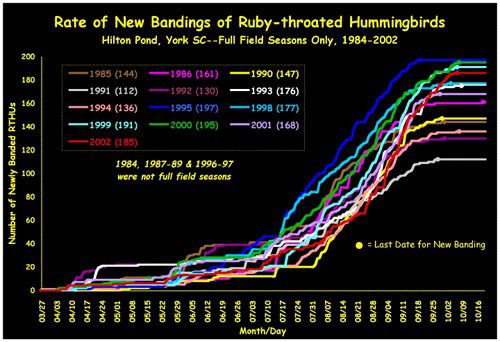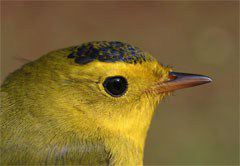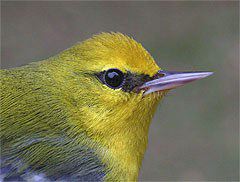|
|
|||
|
THIS WEEK at HILTON POND |
|
The year 2002 has been a curious one for Ruby-throated Hummingbirds at Hilton Pond Center. Following our own advice, we put out our full complement of hummer feeders on St. Patrick's Day (17 March)--well in advance of many enthusiasts. We were rewarded on 30 March with our earliest-ever return of an already-banded ruby-throat, a bird we had captured last year as an adult male. On 5 April we trapped the first unbanded hummer of 2002--another adult male--and he was followed by more adult male recaptures on 5 and 6 April. Why, we even had an adult female show up for banding on 8 April--earlier by five days than any female ruby-throat in our 18-year study. "Ahah!" we said giddily. "This is gonna be a great year for hummingbirds!" 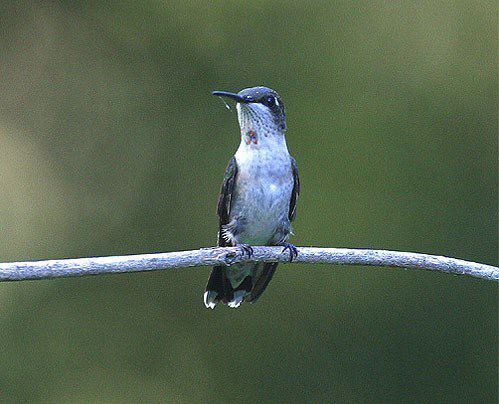 Little did we know after a fast start in late March and early April that the bottom would fall out of the hummer banding business at Hilton Pond Center. After that female on 8 April, we went 21 days before another new capture; May wasn't much better with only eight ruby-throats banded and five returns from previous years. And then came June with a mere four new captures and four returns. Even July--when things usually begin hopping as the first rush of new fledglings takes wing--only brought 21 unbanded hummers and eight returns. To have a yearly total of just 38 new captures by the end of July was depressing and alarming, especially since other banders of Ruby-throated Hummingbirds were reporting their best years ever, and knowing that only August and September stood between us and the long, dark days of "Hummingbirdless Winter." When I told other folks about our low numbers of hummers at Hilton Pond, they usually deduced it was somehow drought-related. After all, 2002 was the fifth consecutive year of below-normal rainfall in the Carolinas and the lack of precipitation WAS having significant impact on flora and wildlife. Although we do catch most of our hummingbird in pull-string devices baited with artificial nectar, we also capture them incidentally in mist nets deployed for our general banding program. Interestingly, when we tabulated those first 38 birds caught March through July, we found that exactly half of them had been netted rather than trapped--perhaps support for the hypothesis they were dining at natural food sources rather than feeders. Regardless, we resigned ourselves at the end of July that this was not going to be a very good year for banding hummingbirds, and we wondered whether we'd reach even 100 birds total for 2002--much less our 18-year average of 138 or our all-time high of 197 shown in the chart below. (Did we mention we were feeling a little depressed?) 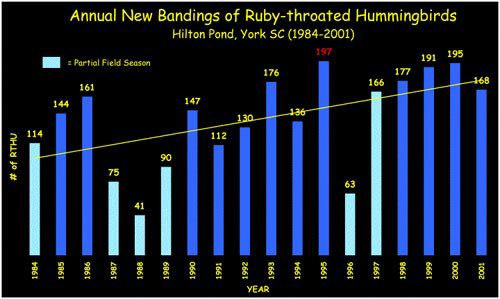 August is typically the best month for trapping hummingbirds. After all, lots of adult ruby-throats are still around and most young of the year already have fledged, including juvenile males like the speckle-throated one in the top photo. Thus, although we do take time to conduct our traditional "Hummingbird Mornings" presentations around the U.S. on late summer weekends, from August through the first half of September we otherwise stay pretty close to Hilton Pond Center, lest we miss out on a sudden rush of hummers. At this point you're probably expecting us to announce that our patience was rewarded and that August 2002 filled our every expectation as a prime banding month for ruby-throats, but such is not the case. That whole month brought a mere 50 new Ruby-throated Hummingbirds, so we had only 88 birds banded and colormarked (below right) when the first of September rolled around. Now we were really in a funk! (Depressed? Us?)
As might be expected, things slowed dramatically as September waned, and October brought just seven new birds--the latest on the 5th. Despite this slowdown, we ended up with 186 new Ruby-thoated Hummingbirds banded in 2002, the fourth best year since our study began in 1984 (see chart above). We don't expect to see any late stragglers, even though our two latest banding dates for a ruby-throat at the Center were 12 and 18 October. In most U.S. locations--Gulf States excepted--95% of all Ruby-throated Hummingbirds are gone by the first of October, and 99.9% have migrated by mid-month. What's really interesting about hummingbird banding in 2002 is that even though we ended up with an acceptable total of 186 new birds--plus 30 returns from previous years--we did indeed have an extremely slow start, as revealed by the chart below. The 2002 banding season is denoted by the red line, which trails well behind almost all other banding years for which we spent a full field season at the Center. This noticeable lag is a phenomenon we can't explain, but unfortunately it may indicate the hummingbird breeding season was locally poor, with most of the late captures in September being migrant birds from elsewhere. We don't know whether the Piedmont drought limited populations of tiny insects that hummingbirds need as a source of fat and protein to build baby birds. Nor do we understand why 22% of our hummers were incidental captures in mist nets when last year it was 10%, or why we caught only 18 new adult males in 2002--compared to an all-time high of 34 in 2000. Such as-yet unsolved mysteries are typical of many aspects of hummer behavior and ecology, so we'll try to get a better grip on what's happening with our Ruby-throated Hummingbirds by committing to another 18 years or so of banding here at Hilton Pond Center. RESULTS OF LAST WEEK'S "FIRST FUN FUNGI QUIZ" Although we weren't overwhelmed by the number of participants in last week's "First Fun Fungi Quiz," we still got some impressive entries. Almost all of them said it was tough to identify mushrooms from photos, especially without being able to examine each one for fine structures that sometimes are the subtle differences among closely related species. The correct answers as we see them:
We've decided not to announce the winner until next week, so as to give the entrants an opportunity to challenge any of the IDs above. The name of the winner--along with any modifications to the above list--will appear in the next installment of "This Week at Hilton Pond." If you enjoy "This Week at Hilton Pond," please help Support Hilton Pond Center for Piedmont Natural History. It's painless, and YOU can make a difference! You may wish to consult our Index of all nature topics covered since February 2000. |

 But right outside the window of the Center's old farmhouse we could see dense thickets of Trumpet Creeper, Campsis radicans--a favorite ruby-throat nectar source--having the best bloom in recent memory, and rides through the Piedmont countryside showed huge numbers of these tubular orange flowers for miles around. Perhaps the hummers were more interested in all that Trumpet Creeper and had no need to lap up sugar water from feeders inside our traps at Hilton Pond Center.
But right outside the window of the Center's old farmhouse we could see dense thickets of Trumpet Creeper, Campsis radicans--a favorite ruby-throat nectar source--having the best bloom in recent memory, and rides through the Piedmont countryside showed huge numbers of these tubular orange flowers for miles around. Perhaps the hummers were more interested in all that Trumpet Creeper and had no need to lap up sugar water from feeders inside our traps at Hilton Pond Center.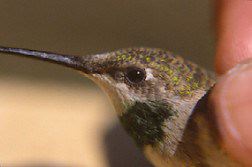 Ever optimistic, we continued to run mist nets and keep our feeders freshly stocked with sugar water. Lo and behold, the hummingbird banding started to improve. We got one new hummer on 2 September, then TWELVE on the 3rd on what turned out to be the best banding day of the whole season. From that point on there was a steady stream of several new ruby-throats almost every day, totalling 117 birds by the end of the first week in September, 149 by mid-month, ten more the next week, and 179 by month's end. We were stunned by this late rush, but at least we weren't depressed any more!
Ever optimistic, we continued to run mist nets and keep our feeders freshly stocked with sugar water. Lo and behold, the hummingbird banding started to improve. We got one new hummer on 2 September, then TWELVE on the 3rd on what turned out to be the best banding day of the whole season. From that point on there was a steady stream of several new ruby-throats almost every day, totalling 117 birds by the end of the first week in September, 149 by mid-month, ten more the next week, and 179 by month's end. We were stunned by this late rush, but at least we weren't depressed any more!